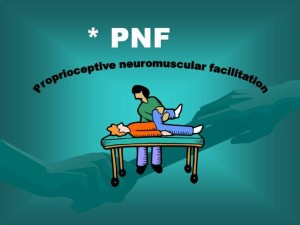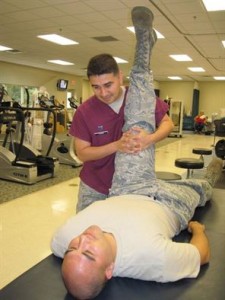Proprioceptive Neuromuscular Facilitation (PNF) is a form of stretching that uses an isometric contraction ( a volun-tary contraction in which no joint movement occurs and muscle length is unchanged) . It is done prior to the stretch to achieve greater gains than from stretching alone. Dramatic gains in flexibility are possible in a very short time with this technique, due to the creative use of a few neurological mechanisms to optimize a muscle’s ability to lengthen. PNF is based on several neurophysiological mechanisms.

One such mechanism is the Golgi tendon organs (GTOs) which work to relax a muscle. The Golgi tendon organs are located in the muscle tendon and monitor the amount of strain on the tendon. Strain develops in the tendon when the muscle contracts and is pulled on. Theoretically, if too much load or strain is put on the muscle, the inverse stretch reflex, mediated by the GTO’s, should cause it to relax. Strain is also sensed by the GTOs when the muscle is stretched, because the tendon is once again being pulled. When a muscle stretch is held, the pull on the tendons should stimulate the GTOs and cause the muscle to relax and lengthen further to reduce the chances of muscle tear¬ing.
PNF techniques were developed as patterns of movement to increase strength, coordination, and flexibility through entire ranges of motion. PNF stretching is not meant to replace the daily stretching routine that every person should already have in place. PNF is used to make quick gains in range of motion and flexibility, and daily stretching is im¬portant to maintain these gains.
PNF Stretching Procedures: may be performed in a chiropractic or massage therapy treatment
- The muscle is lengthened to its maximal pain-free end of range. For example, if Dr. Rodwin wants to stretch the hamstring, she will have you lie on your back and will actively lift your leg as high as possible, keeping the knee straight. This stretches the hamstrings to its end of range.
- The Dr. or therapist will position his/herself to act as the resistance so that you can gently contract the muscle against this resistance.
- You will then actively contract (push) the muscle against the resistance the Dr. or therapist applies. The contraction should begin gradually and build to 50% to 100% of maximum force, in a controlled manner. Muscles need oxygen to work properly, so you should to continue to breath during the stretch. The contraction is held for approximately 6 seconds.
- You will then relax and continue to breathe. Your muscle will be held in the relaxed position for several seconds.
- Your muscles can now be put into a deeper stretch. Do not push to deepen the stretch. The muscles will easily move into this new position and the Dr. or therapist will have you go through steps 3 and 4 again.
- Each time this is performed the muscle will be lengthened a bit further.



